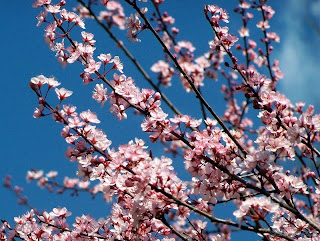
On a recent drive from San Diego to San Francisco up highways 101 and 1, the flowering plums were the floral harbingers of spring. These trees are part of the genus Prunus which is best known horticulturally for the hundreds of cultivated ornamental and fruiting varieties of plum, cherry, apricot, peach and nectarine. The genus can be divided into into two categories: evergreen and deciduous. It was the latter of these, the deciduous flowering variety, that stole the show all up and down the coast during the first week of February. Here are just three of the popular flowering plum cultivars that are for ornamental use:
Prunus cerasifera'Kratuer Vesuvius' is a smaller tree 18ft tall by 12 ft. wide. Have you ever been to Bakersfield CA in the summer? Well that's where this variety was cultivated, therefore it definitely shows a greater tolerance of heat and drought conditions and is well suited to San Diego's warmer inland areas. The purple-black foliage is the darkest of the flowering plums and the flowers are a single bloom of light pink.
Prunus cerasifera 'Atropurpurea' ( 'Pissardii') will grow rather quickly up to 30 ft and width. It's the traditional Purple-Leaf-Plum. The leaves are coppery red when new, later deepening to dark purple then turning res in autumn before dropping. The single blooms can be white or the palest of pinks. Some produce a crop of red fruit.
Prunus cerasifera 'Purple Pony' is the smallest of the three discussed today. It is considered a semi-dwarf coming in at a mature height if only 10-12 ft with a canopy width about the same. This is a great choice for patio or any hardscape area planting, because is bears no fruit. The leaves maintain their rich purple color through fall. The blooms are single pink flowers in the spring.
The flowering plum can thrive in far more climate and soil conditions than other trees from the genus, like the flowering cherry or peach. It's this adaptability that allows the Prunus cerasifera to be a color-contrasting addition to so many California gardens. When the showy blooming has passed the foliage of most varieties is just as dramatic and aesthetically pleasing.
A floral design idea: These blooming branches can be cut for decoration. Make your branch selection with an eye that's taking the entire canopy shape into consideration. (For newly planted trees select a rubbing branch or the weaker limb of a double leader) For the longest lasting bloom, cut the branches when the buds first begin to open. Place the branch in a deep container of water, then strip off any buds or flowers that will be below the water level. Enjoy!
Prunus cerasifera'Kratuer Vesuvius' is a smaller tree 18ft tall by 12 ft. wide. Have you ever been to Bakersfield CA in the summer? Well that's where this variety was cultivated, therefore it definitely shows a greater tolerance of heat and drought conditions and is well suited to San Diego's warmer inland areas. The purple-black foliage is the darkest of the flowering plums and the flowers are a single bloom of light pink.
Prunus cerasifera 'Atropurpurea' ( 'Pissardii') will grow rather quickly up to 30 ft and width. It's the traditional Purple-Leaf-Plum. The leaves are coppery red when new, later deepening to dark purple then turning res in autumn before dropping. The single blooms can be white or the palest of pinks. Some produce a crop of red fruit.
Prunus cerasifera 'Purple Pony' is the smallest of the three discussed today. It is considered a semi-dwarf coming in at a mature height if only 10-12 ft with a canopy width about the same. This is a great choice for patio or any hardscape area planting, because is bears no fruit. The leaves maintain their rich purple color through fall. The blooms are single pink flowers in the spring.
The flowering plum can thrive in far more climate and soil conditions than other trees from the genus, like the flowering cherry or peach. It's this adaptability that allows the Prunus cerasifera to be a color-contrasting addition to so many California gardens. When the showy blooming has passed the foliage of most varieties is just as dramatic and aesthetically pleasing.
A floral design idea: These blooming branches can be cut for decoration. Make your branch selection with an eye that's taking the entire canopy shape into consideration. (For newly planted trees select a rubbing branch or the weaker limb of a double leader) For the longest lasting bloom, cut the branches when the buds first begin to open. Place the branch in a deep container of water, then strip off any buds or flowers that will be below the water level. Enjoy!
Visit our website to see the Torrey Pines Landscape Company portfolio and learn about our services.


Comments
Post a Comment